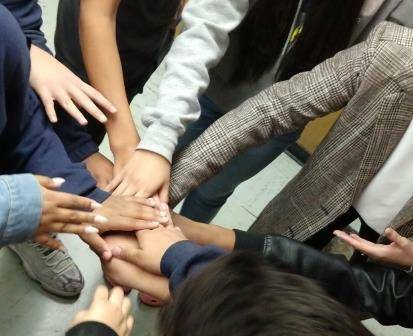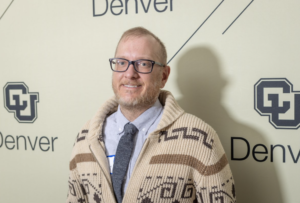We at the University of Colorado-Denver frame our master’s level Curriculum Theories course with a contentious quote: “Curriculum in any time and place becomes the site of a battleground where the fight is over whose values and beliefs will achieve the legitimization and the respect that acceptance into the national discourse provides” (Kliebard, 1995, p. 250-251).
While the battlefield language is a bit much for some practicing classroom teachers in the course, more so than ever classrooms are sites of struggle around whose voice is centered and whose is erased. For educators in those classrooms, the struggle is especially real. The Curriculum Theories course last fall helped them make sense of this political climate, identify personal implications, and embark in action research to begin making some shifts in their curriculum and pedagogy.
The outputs were staggeringly good. While we wish we could share essays from all 42 of the classroom teachers who were students in the course, we’ve prepared eight essays that highlight a teacher’s dive into action research around their classroom practice.
Before we share those essays, however, we’d like to give a bit more context about the course, which caters to teachers in the classroom. After contemplating Kliebard’s quote and reading a piece with similar sentiment (Charles Blow’s 2022 New York Times column), the teachers dove into Eisner’s (1994) foundational work examining the explicit, hidden, and null curricula. Essentially, Eisner argues, teachers make decisions about what to explicitly center in their classroom; doing so naturally establishes a null curriculum (what isn’t covered) and that in turn sends hidden or implicit messages. For example, explicitly centering only white authors places the work of writers of color in the null curriculum, sending implicit messages that white canon and experience is most important.
The course then shifts toward Schiro’s (2012) exploration of four curriculum orientations: scholar academic (content is king); social efficiency (workforce preparation dominates); learner centered (think: Montessori), and social reconstruction (critiquing social problems and developing more just solutions). Most teachers lamented the fact that they worked in schools that tilted more toward the scholar academic and social efficiency orientations, as opposed to the learner centered and social reconstruction orientations that seemed to more deeply honor the humanity of students. The social reconstruction stance, which many teachers in the class argued is the cradle for critical pedagogy and participatory action in education, sparked the most interest.
The final text that every teacher in the class read involved Baker-Bell and colleagues’ (2017) exploration of the nexus of media and curriculum bias. Baker-Bell and colleagues argue that the media portrays Black youth in hurtfully negative ways that carry over to the classroom. Teachers then are charged with either reaffirming or interrupting those harmful narratives. The authors provide concrete lesson plans to center Black voices and critique media portrayals, which piqued teachers’ interest in the course.
Teachers then chose to explore one of six pathways: critical race theory, critical literacy, LGBTQ+ concerns, decolonizing teaching, whiteness in the classroom, and understanding poverty. In each path, teachers formed small grounds, read foundational articles, engaged with multimedia materials, and read a central book about the topic.
With all of this learning and reading synthesized, teachers then identified personal implications for their specific classrooms. Those implications provided the charge for their action research projects. You’ll be hearing from eight of those teachers over the next few weeks. They include:
Cameron Neumann making space for humanity in behaviorist public school classrooms, https://www.socialpublishersfoundation.org/knowledge_base/the-standoff-against-curriculum/
Daniele Skor examining the link between curricular demands and teacher shortages, https://www.socialpublishersfoundation.org/knowledge_base/curriculum-ideology-wars-and-the-post-pandemic-teacher-shortage/
Dominic Repucci creating professional development for fellow teachers around the myths and realities of students living in poverty, https://www.socialpublishersfoundation.org/knowledge_base/undergirded-with-urgency/
Frank Miller exploring the intersection of academic success, cultural competence and sociopolitical consciousness, https://www.socialpublishersfoundation.org/knowledge_base/curriculum-created-from-fear-and-doused-in-ignorance/
Guillermo Vela creating anti-racist lessons in high school classrooms, https://www.socialpublishersfoundation.org/knowledge_base/worn-out-critical-pedagogy-and-implications/
Milahd Makooi Implementing youth participatory action research in a middle-school classroom, https://www.socialpublishersfoundation.org/knowledge_base/flipping-the-script-rewriting-the-argument-for-ypar-in-classrooms/
Meghan Tocci revising methodology to mediate curricular oppression, https://www.socialpublishersfoundation.org/knowledge_base/curriculum-a-tool-of-the-oppressor/
Sumner True deepening the link between IEPs, equity literacy, and novel selection in English courses, https://www.socialpublishersfoundation.org/knowledge_base/embracing-change-addressing-bias-and-misconception-in-the-academic-setting/
We hope you are impressed and inspired by these teachers’ work. We at CU-Denver certainly are.
References
Baker-Bell, A., Stanbrough, R. J., & Everett, S. (2017). The stories they tell: Mainstream media, pedagogies of healing, and critical media literacy. English Education, 49(2), 130–151.
Blow, C. M. (2021, August 18). How our classrooms became battlegrounds. The New York Times. https://www.nytimes.com/2021/08/18/opinion/united-states-classrooms-conflicts.html
Eisner, E. (1994). The educational imagination: On the design and evaluation of school programs. Merrill Prentice Hall.
Kliebard, H. M. (1995). The struggle for the American curriculum. 2nd ed. Routledge.
Schiro, M. S. (2012). Curriculum Theory: Conflicting Visions and Enduring Understandings. 2nd ed. Sage.
To cite this work, please use the following reference:
Stickney, D. (2023, May 23). Putting curricular theories into action. Social Publishers Foundation. https://www.socialpublishersfoundation.org/knowledge_base/putting-curricular-theories-into-action/

